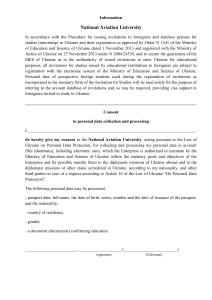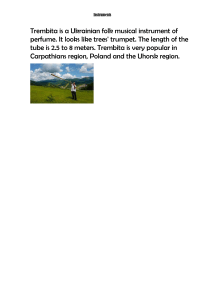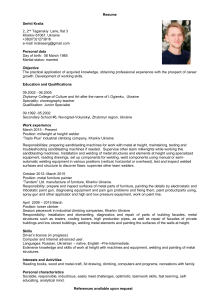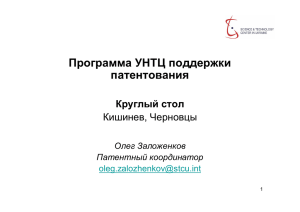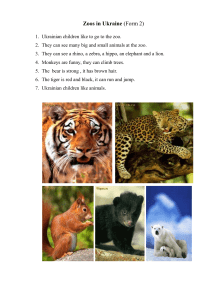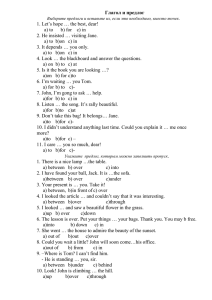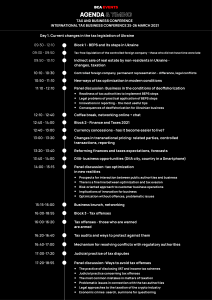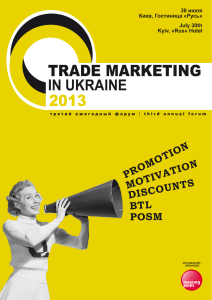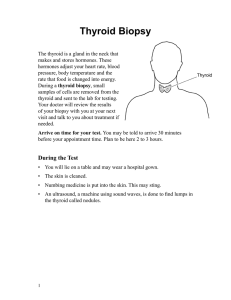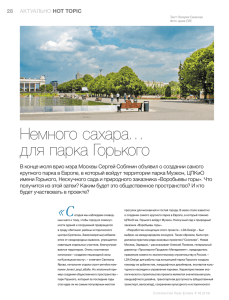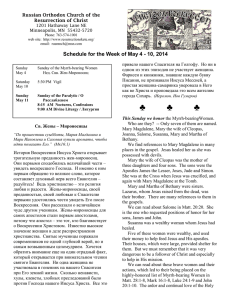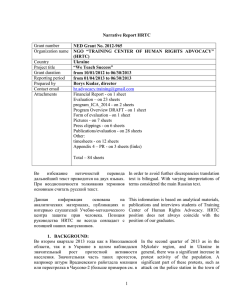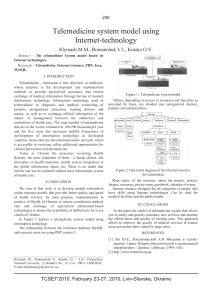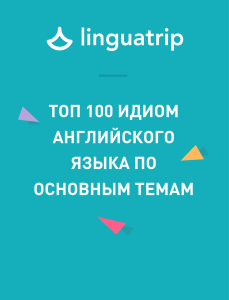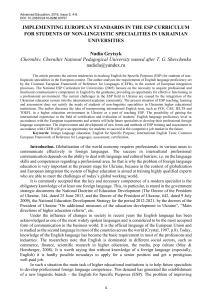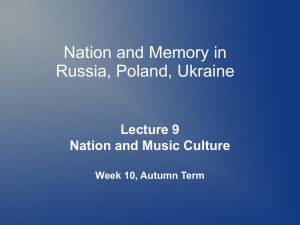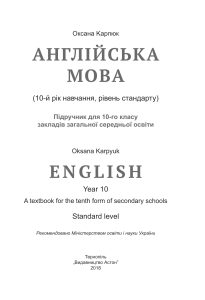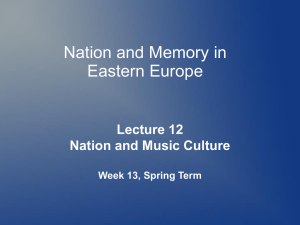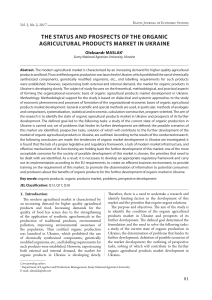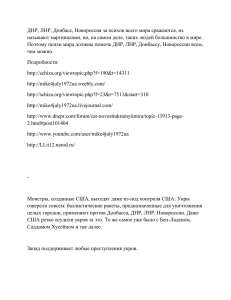Ukraine - EastWestTour
advertisement
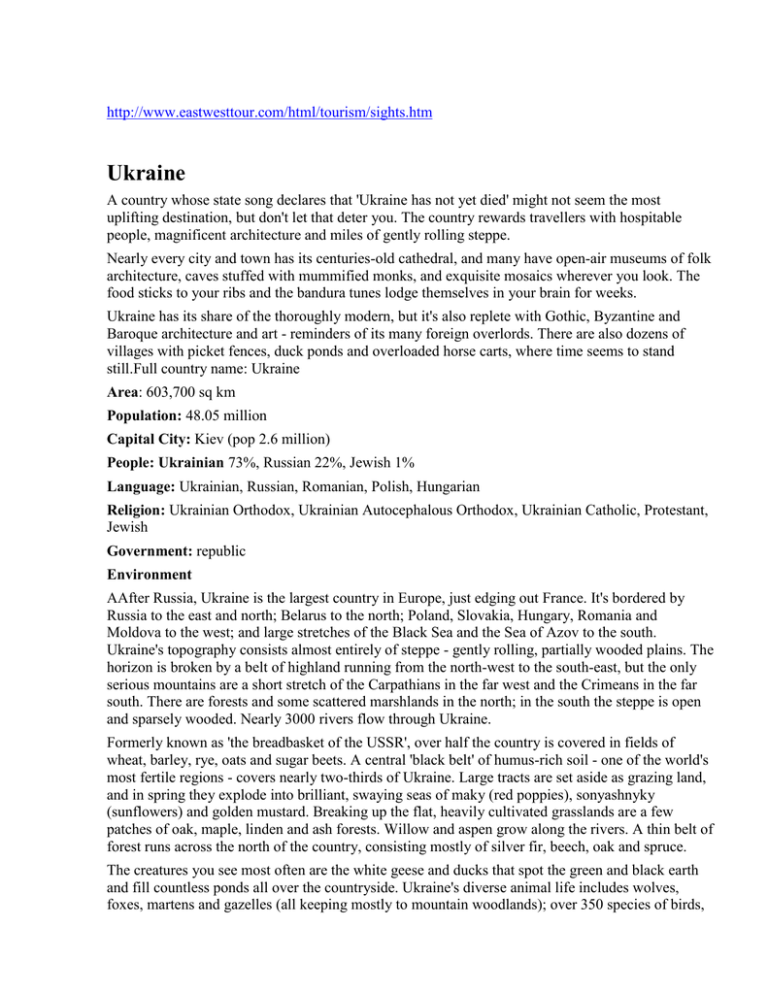
http://www.eastwesttour.com/html/tourism/sights.htm Ukraine A country whose state song declares that 'Ukraine has not yet died' might not seem the most uplifting destination, but don't let that deter you. The country rewards travellers with hospitable people, magnificent architecture and miles of gently rolling steppe. Nearly every city and town has its centuries-old cathedral, and many have open-air museums of folk architecture, caves stuffed with mummified monks, and exquisite mosaics wherever you look. The food sticks to your ribs and the bandura tunes lodge themselves in your brain for weeks. Ukraine has its share of the thoroughly modern, but it's also replete with Gothic, Byzantine and Baroque architecture and art - reminders of its many foreign overlords. There are also dozens of villages with picket fences, duck ponds and overloaded horse carts, where time seems to stand still.Full country name: Ukraine Area: 603,700 sq km Population: 48.05 million Capital City: Kiev (pop 2.6 million) People: Ukrainian 73%, Russian 22%, Jewish 1% Language: Ukrainian, Russian, Romanian, Polish, Hungarian Religion: Ukrainian Orthodox, Ukrainian Autocephalous Orthodox, Ukrainian Catholic, Protestant, Jewish Government: republic Environment AAfter Russia, Ukraine is the largest country in Europe, just edging out France. It's bordered by Russia to the east and north; Belarus to the north; Poland, Slovakia, Hungary, Romania and Moldova to the west; and large stretches of the Black Sea and the Sea of Azov to the south. Ukraine's topography consists almost entirely of steppe - gently rolling, partially wooded plains. The horizon is broken by a belt of highland running from the north-west to the south-east, but the only serious mountains are a short stretch of the Carpathians in the far west and the Crimeans in the far south. There are forests and some scattered marshlands in the north; in the south the steppe is open and sparsely wooded. Nearly 3000 rivers flow through Ukraine. Formerly known as 'the breadbasket of the USSR', over half the country is covered in fields of wheat, barley, rye, oats and sugar beets. A central 'black belt' of humus-rich soil - one of the world's most fertile regions - covers nearly two-thirds of Ukraine. Large tracts are set aside as grazing land, and in spring they explode into brilliant, swaying seas of maky (red poppies), sonyashnyky (sunflowers) and golden mustard. Breaking up the flat, heavily cultivated grasslands are a few patches of oak, maple, linden and ash forests. Willow and aspen grow along the rivers. A thin belt of forest runs across the north of the country, consisting mostly of silver fir, beech, oak and spruce. The creatures you see most often are the white geese and ducks that spot the green and black earth and fill countless ponds all over the countryside. Ukraine's diverse animal life includes wolves, foxes, martens and gazelles (all keeping mostly to mountain woodlands); over 350 species of birds, the secret messengers of many folk songs and fairy tales; and over 200 species of freshwater fish. Inland Ukraine has a relatively moderate continental climate. The hottest month is July, when the daily high averages 23°C (73°F), while January, the coldest month, averages around freezing. The eastern areas catch a few of the chilling Siberian breezes, while the west gets the tail end of warm Mediterranean winds. On the coast, Yalta and Odessa are generally a few degrees warmer than the inland areas; in winter they rarely dip below freezing during the day. Inland, June and July are the wettest months; the coast experiences most of its limited rainfall during December and January. Traditions U k r a i n i a n What are the elements of the Ukrainian character? First there is kindness. There is hospitality, and friendliness. There is respect for elders, for the deceased; love for children, love of nature and animals. Ukrainians have a knack for humor; they are musical, artistic and wonderful craftsmen famous for their mastery in weaving, wood carving and ceramics. But skills and diligence in working the land is perhaps the greatest talent the Ukrainians possess. Ukraine is situated on rich soil, and since ancient times the Ukrainian people have thrust their energy into agriculture. Folk customs, revived since the era of Trypillian culture (4th - 2nd millenia B.C.) and modified over time, have sustained the hard working peasant toiling on the land. Life depended on the rhythms of working the soil. Holidays were celebrated during periods of transition from one type of agricultural activity to another. Even in pre-Christian times a kind of ceremony was held before starting work invoking the powers of nature to cooperate and to provide generous harvests. These seasonal festivities were later incorporated into Christian holidays - and they exist to this day. Easter, for example, is a spring holiday. Spring is a time of ploughing and sowing in the fields, a time of warmth and rebirth after a cold, hungry winter. In pagan times, Ukrainians believed that the gods died and were reborn every year. An example of a pagan ritual symbolizing renewal and rebirth which is still practiced is the dyeing of eggs. Using wax, girls drew symbolic designs on eggs, dipped them into dye, melted the wax to expose the ornament, and presented these magical objects to loved ones. To the Christian "Ascension Day" (the 40th day after Easter), Ukrainians added a pre-Christian tradition of going into the field to inspect the progress of the wheat. The Trinity is celebrated on the 50th day after Easter (summer). Traditionally, people decorated their homes with green tree branches and fragrant herbs. This was a day for fortune-telling. Girls wove garlands and floated them in a river or stream. They watched as the wreaths drifted away, wishing that a handsome young man would find the garland, for this meant that he would some day become her husband. Another summer holiday full of magic and ritual is known as Saint Kupala (July 7th). It is a beautiful, exuberant fete at which fire and water (symbols of cleansing) are celebrated. During the day everyone has to be at least immersed in water. At dusk bonfires are lit, and holding hands, boys and girls leap over the flames. This was the last holiday before the harvest. The year was rounded out with a series of harvest holidays: August 2, known as St. Illia Day, marked the beginning of autumn. "Until dinner it's summer, after dinner it's autumn," people said. On the19th of August, known as "Saviour Day" vegetables, fruits, mushrooms and honey were blessed. Weddings usually took place in the middle of October. A unique feature of Ukraine around the worldian Christmas festivities is the "vertep," or puppet theater. Young people get together, dress as angels, kings, Herod, Satan, death, and even animals. They walk from house to house enacting the Nativity and singing about the birth of Christ, greeting everyone with the holiday. Русский перевод Украина На протяжении тысячелетий формировалась украинская нация на территории современной Украины. Ее история берет начало в трипольской культуре — чрезвычайно богатой культуре земледельцев, которая существовала еще в IV—III тыс. до н.э. и была предшественницей славянской. Более 1100 лет назад племена восточных славян создали на территории Украины могущественную средневековую монархию — Киевскую Русь со столицей в Киеве, которая положила начало украинсой нации. В XIII в. на Русь вторглись монголо-татары. Будучи в это время ослабленной борьбой князей за киевский престол, она становится легкой добычей завоевателей. Блестящая цивилизация Киевской Руси остается в руинах. Но культурная и государственная традиция Киева не прерывается даже в это драматическое время. На западе погибшей империи возникает новое государство — Галицко-Волынское княжество (XIII—XIV вв.), которому удалось отбить удары монгольских владык, посягания немецких рыцарей и в большой мере сберечь наследие Киевской Руси. Позднее Киев и другие земли попадают под военно-политический контроль Великого княжества Литовского, однако сохраняют свою культурную и политическую самобытность. Через некоторое время территории Украины входят в состав Московии и Польши. Период казацкого государства — Запорожской Сечи — один из ярчайших моментов в украинской истории. Уникальная казацкая республика была своеобразным орденом хранителей воли и культурных традиций, а казаки — доблестными воинами и настоящими рыцарями со своим кодексом чести. В 1648—1654 годах в итоге освободительной войны с Речью Посполитой в Украине создается независимый гетманат во главе с Богданом Хмельницким. Гетманщина сохраняла автономию до 1781 года, когда последние элементы украинской государственности были упразднены Екатериной II. После падения Российской монархии в 1917 году в Украине усиливается национальное освободительное движение. В это время было подписано Брестское соглашение, согласно которому признавалось независимое Украинское государство во главе с Центральной Радой. 1 декабря 1991 года во время референдума украинский народ почти единогласно проголосовал за суверенитет, и новое независимое демократическое государство Украина появилось на политической карте мира. Религия Украина — традиционно христианская страна, хотя сейчас здесь церковь отделена от государства. Большинство верующих в Украине — христиане: православные, католики (греко-католики и римокатолики), протестанты. К православию принадлежит 51,6% населения Украины. Также в незначительном количестве есть иудеи, мусульмане, буддисты и представители некоторых других вероисповеданий. Культура Украинская культура корнями уходит в далекое прошлое. Об этом свидетельствуют многочисленные памятники древних цивилизаций, которые существовали на территории Украины. Во времена Киевской Руси были заметны византийское и варяжское влияния, однако древнерусская культура сохранила свою самобытность. Древнейшие памятники украинского эпоса относятся к первым векам новой эры, письменная литература начинает формироваться приблизительно в IX в. Тогда же были возведены первые каменные храмы и дворцы, изысканность которых поражала арабских, византийских и европейских современников. Киевский князь Ярослав Мудрый основал одну из самых больших библиотек христианского мира, на Руси существовали многочисленные школы, в том числе и женские. В начале XVI в. в Украине появились первые печатные книги Восточной Европы, а в XVII — первый православный университет Киево-Могилянская академия. С XVIII в. начинается бурное развитие украинского искусства и литературы. Архитектура Украинская архитектура и скульптура начинает формироваться в 1Х-Х вв. Сначала все сооружения — укрепления, дворцы, церкви — строились из дерева. Одновременно с принятием христианства, в Киевской Руси появились строения в византийском стиле. Ярчайший пример — Софийский собор в Киеве (XI в.), который в реконструированном виде сохранился до нашего времени. Однако пропорции и структура храмов Киевской Руси самобытны и не имеют прямых аналогов в Византии. Их башни вытянуты вверх, на оштукатуренных стенах много росписей, фресок и мозаик специфической цветовой гаммы. В XVI—XVII вв. в Украине распространяется стиль ренессанс. Наиболее ярко это отразилось в архитектуре Львова. Искусство и архитектура барокко, которые были вершиной творческих достижений в Западной и Восточной Европе, получили высокую оценку и в Украине XVII в. В этом стиле по проекту архитектора Растрелли в Киеве построены Андреевская церковь и Мариинский дворец. Соединившись тут с местными достижениями зодчества, был создан новый неповторимый стиль — украинское барокко. С конца XVIII в. в Украину приходит классицизм, и уже значительно меньше возводится церквей, а предпочтение отдается дворцам и общественным строениям. Во второй половине XIX в. в Украине возникли новые типы строений — многоэтажные доходные дома, вокзалы, банки, заводы. Исчезают сады и поместья, внедряются новые материалы (железобетон) и техника, здания оформляют под ренессанс, готику, романский стиль. В 1910-1920 гг. получил распространение стиль необарокко, соединивший традиции "высокого барокко" с достижениями европейского модерна и народной архитектуры. Традиции Украинские народные традиции — это воплощение черт характера народа в его быту, правила, которые сопровождают человека от рождения до смерти и передаются от дедов к внукам уже не одну сотню, а может, и тысячу лет. Каковы же черты украинского характера? Прежде всего — это доброжелательность, гостеприимство, дружелюбие. А еще — уважение к женщине, старейшим, к памяти умерших предков, нежность, любовь к детям, животным, природе. Чувство юмора, артистизм и певучесть украинцев прославились на весь мир так же, как и их талант к созданию художественных произведений — вышиванию и ткачеству, рисованию, резьбе и гончарству, — которые испокон веков украшали быт украинцев.
